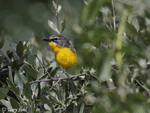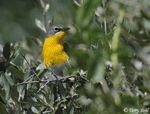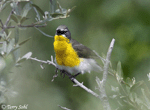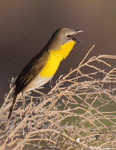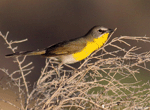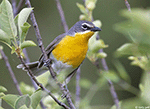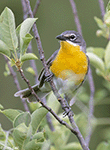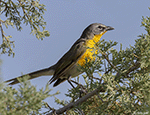| Length: 7.25 inches | Wingspan: 9.5 inches | Seasonality: Summer / Migrant |
| ID Keys: Bright yellow throat and breast, dark olive-grey upperparts, distinct white eye-ring, thick bill | ||
 The Yellow-breasted Chat was once considered the
largest warbler
found in the United States. Recent genetic analysis has brought into doubt
whether they truly are warblers, however, and as of 2017, the American
Ornithological Society has moved the species to its own family. Its behavior is more like a thrasher or a
catbird, as it prefers to hide in dense cover, giving off a sometimes bizarre
series of calls. Males are sometimes easier to observe, as they fly over
the undergrowth with legs dangling, singing as they go.
The Yellow-breasted Chat was once considered the
largest warbler
found in the United States. Recent genetic analysis has brought into doubt
whether they truly are warblers, however, and as of 2017, the American
Ornithological Society has moved the species to its own family. Its behavior is more like a thrasher or a
catbird, as it prefers to hide in dense cover, giving off a sometimes bizarre
series of calls. Males are sometimes easier to observe, as they fly over
the undergrowth with legs dangling, singing as they go.
Habitat:
During breeding season, prefers very brushy thickets, such as those found along streams, woodland and swamp edges, and overgrown pastures.
Diet:
Insects, and unlike many warblers, depends heavily on berries and other fruits.
Behavior:
Usually forages alone, clambering through brushy thickets in search of insects and berries.
Nesting:
June and July. The female builds the nest, constructing a cup of grasses and other plant stems, leaves, strips of bark, and moss, and lines it with finer material including fine grasses, hair, and rootlets. It is placed relatively low to the ground (generally less than 10 feet) in very thick, shrubby vegetation. She incubates the eggs for about 12 days before they hatch. The young fledge from the nest after another 10-12 days.
Song:
The song of a Yellow-breasted Chat is an odd mix of cackles and musical phrases.
1Click here to hear the singing of a Yellow-breasted Chat
2Click here to hear another version of a singing Yellow-breasted Chat
3Click here to hear a short cuk call of a Yellow-breasted Chat
Migration:
Summers throughout much of the United States. Winters in Mexico and points south. Small numbers, however, do overwinter along the U.S. east coast every year, even as far as New England.
Interactive eBird map:
Click here to access an interactive eBird map of Yellow-breasted Chat sightings
Similar Species:
Generally distinctive
Bird Feeders:
Those that overwinter in the eastern U.S. sometimes come to feeders for suet or peanut butter. Will also sometimes come to feeders for sugar water and nectar, or certain fruits.
Conservation Status:
Has declined locally in parts of the Southwest, but has increased its numbers in the Southeast due to brushy habitats created by forest clearing. Overall numbers are generally stable, and there are no perceived systematic threats to the population. The IUCN considers the Yellow-breasted Chat to be a species of "Least Concern".
Further Information:
1) USGS Patuxent Bird Identification InfoCenter, Yellow-breasted Chat
2) Cornell Lab of Ornithology - Yellow-breasted Chat
3) WhatBird - Yellow-breasted Chat
Photo Information:
July 23rd, 2011 - North Cave Hills, Harding County, South Dakota - Terry Sohl
Additional Photos:
Click on the image chips or text links below for additional higher-resolution photos of this species.
Audio File Credits:
1Steve Hampton. Recorded in Yolo County, California on May 8th, 2020. Original recording and information available from xeno-canto.
2Ted Floyd. Recorded in Boulder County, Colorado on July 1st, 2018. Original recording and information available from xeno-canto.
3Richard E. Webster. Recorded in Sonora, Mexico on July 12th, 2006. Original recording and information available from xeno-canto..
| Click on the map below for a higher-resolution view |
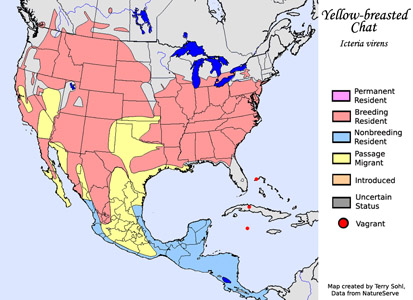 |
| South Dakota Status: Uncommon summer resident in the western part of the state, rare migrant in the east. |
Click here for
a photo page dedicated to Yellow-breasted Chat
Click below for a higher-resolution version of these photos
